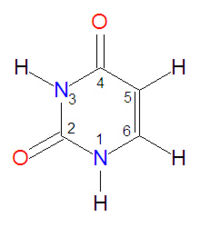Uracil: Difference between revisions
Jump to navigation
Jump to search


imported>David E. Volk (New page: {{subpages}}) |
imported>David E. Volk No edit summary |
||
| Line 1: | Line 1: | ||
{{subpages}} | {{subpages}} | ||
{{subpages}} | |||
{{Chem infobox | |||
|align=right | |||
|image=[[Image:Uracil.jpg|center|thumb|200px]] | |||
|width=200px | |||
|molname=uracil | |||
|synonyms= | |||
|molformula= C<sub>4</sub>H<sub>4</sub>N<sub>2</sub>O<sub>2</sub> | |||
|molmass= | |||
|uses= RNA base | |||
|properties= | |||
|hazards= | |||
|iupac= | |||
|casnumber= | |||
}} | |||
'''Uracil''' is one of the bases found in [[RNA]]. In RNA, the H<sup>1</sup> proton is removed and the N<sup>1</sup>-nitrogen atom is bound the the C1' carbon of [[ribose]]. It is analogous in structure to [[thymidine]], which can be thought of as 5-methyl-uracil, and it usually forms base pairs with [[adenine]] (A) in RNA. In an adenine-uracil base pair, the O4 oxygen atom of uracil forms a hydrogen bond with one of the amino protons (H61) of adenine. A second hydrogen bond is formed between the uracil H3 proton and the adenine N1 nitrogen atom. Like other nucleotide bases, it is subject to oxidative damage. | |||
Revision as of 09:38, 19 June 2008
|
| |||||||
| uracil | |||||||
| |||||||
| Uses: | RNA base | ||||||
| Properties: | |||||||
| Hazards: | |||||||
| |||||||
Uracil is one of the bases found in RNA. In RNA, the H1 proton is removed and the N1-nitrogen atom is bound the the C1' carbon of ribose. It is analogous in structure to thymidine, which can be thought of as 5-methyl-uracil, and it usually forms base pairs with adenine (A) in RNA. In an adenine-uracil base pair, the O4 oxygen atom of uracil forms a hydrogen bond with one of the amino protons (H61) of adenine. A second hydrogen bond is formed between the uracil H3 proton and the adenine N1 nitrogen atom. Like other nucleotide bases, it is subject to oxidative damage.
